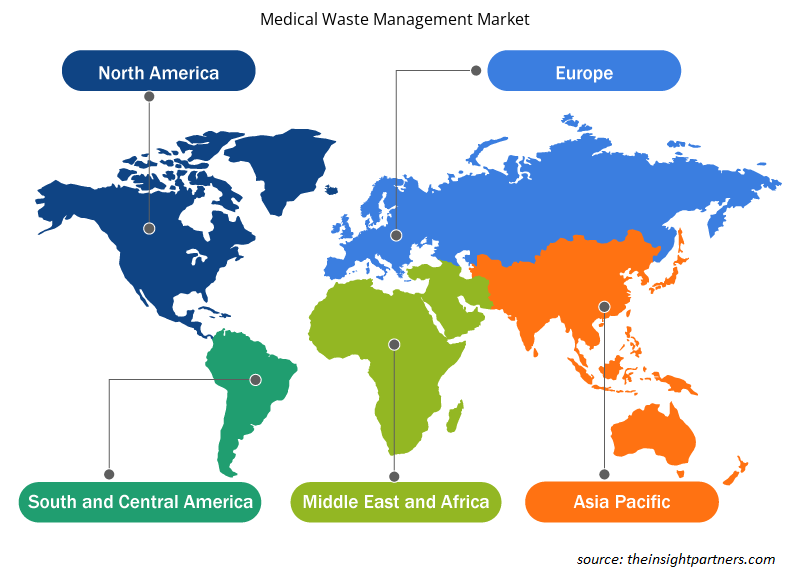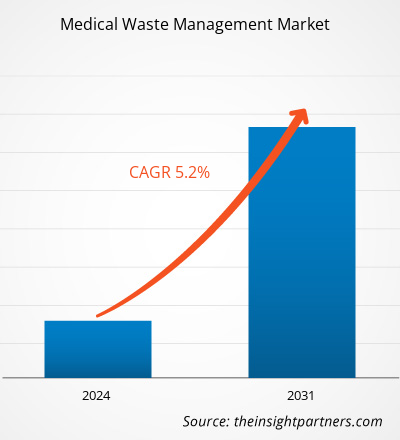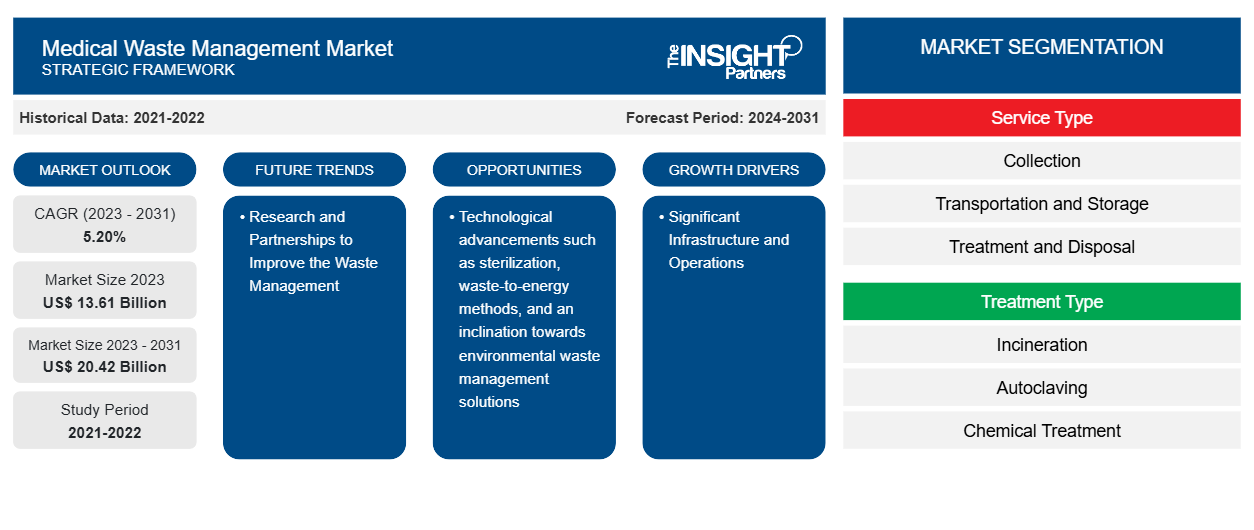بلغت قيمة سوق إدارة النفايات الطبية 13.61 مليار دولار أمريكي في عام 2023 ومن المتوقع أن تصل إلى 20.42 مليار دولار أمريكي بحلول عام 2031. ومن المتوقع أن يسجل السوق معدل نمو سنوي مركب بنسبة 5.20٪ في الفترة 2023-2031. ومن المرجح أن تظل التطورات التكنولوجية مثل التعقيم وطرق تحويل النفايات إلى طاقة والميل نحو حلول إدارة النفايات البيئية من الاتجاهات الرئيسية لسوق إدارة النفايات الطبية.
تحليل سوق إدارة النفايات الطبية
تُسمى النفايات التي تنتجها مراكز المرافق الطبية وشركات معالجة العلوم الحيوية بالنفايات الطبية. تشمل النفايات الطبية الناتجة عن عمليات الرعاية الصحية الضمادات المتسخة والدم والمواد الكيميائية وأجزاء الجسم والمعدات الطبية والعينات التشخيصية، من بين أشياء أخرى. تتحكم إدارة النفايات الطبية في إنتاج هذه النفايات الطبية ومعالجتها والتخلص منها. تساهم الكمية المتزايدة من النفايات الطبية والمبادرات التي تم تنفيذها لإدارتها والعدد المتزايد من حالات دخول المرضى في جميع أنحاء العالم في نمو سوق إدارة النفايات الطبية العالمية.
نظرة عامة على سوق إدارة النفايات الطبية
إن إدارة النفايات تشكل جزءًا لا يتجزأ من الرعاية الصحية. إن العاملين في مجال الرعاية الصحية، والعاملين في مجال معالجة النفايات، وعامة الناس معرضون جميعًا لخطر الإصابة بالعدوى والآثار الضارة والإصابات والتلوث البيئي عندما لا تتم إدارة النفايات الطبية بشكل صحيح. في عام 2014، أنشأت منظمة الصحة العالمية الإدارة الآمنة للنفايات الناتجة عن أنشطة الرعاية الصحية، وهي أول وثيقة إرشادية شاملة على مستوى العالم. يغطي الدليل جوانب مثل الإطار القانوني، ومخاوف التخطيط، وإعادة التدوير والحد من النفايات ، وخيارات المناولة والتخزين والنقل والمعالجة والتخلص منها، والتدريب.
قم بتخصيص هذا التقرير ليناسب متطلباتك
ستحصل على تخصيص لأي تقرير - مجانًا - بما في ذلك أجزاء من هذا التقرير، أو تحليل على مستوى الدولة، وحزمة بيانات Excel، بالإضافة إلى الاستفادة من العروض والخصومات الرائعة للشركات الناشئة والجامعات
-
احصل على أهم اتجاهات السوق الرئيسية لهذا التقرير.ستتضمن هذه العينة المجانية تحليلاً للبيانات، بدءًا من اتجاهات السوق وحتى التقديرات والتوقعات.
محركات وفرص سوق إدارة النفايات الطبية
بنية تحتية وعمليات مهمة لصالح السوق
من المرجح أن يؤدي التركيز القوي على طرق أكثر أهمية لتوقع وإدارة احتياجات العرض لتعزيز البنية التحتية إلى تعزيز نمو السوق. تساعد برامج تثقيف الموظفين السريري حول أنواع النفايات البلاستيكية وإجراءات إعادة التدوير والفرز لتعظيم الالتزام بالمبادئ التوجيهية على تحسين العمليات. تطوير خطوط الأنابيب لتوزيع الإمدادات الطبية غير المستخدمة داخل شبكات المؤسسات المحلية للحد من النفايات والإنفاق المالي. وهذا بدوره يدفع السوق إلى التوسع. على سبيل المثال، في يوليو 2022، وقع برنامج الأمم المتحدة الإنمائي في العراق ووزارة الصحة صفقة بقيمة 25 مليون دولار أمريكي لتحسين إدارة النفايات الطبية في البلاد.
البحث والشراكات – فرصة في سوق إدارة النفايات الطبية
ومن المرجح أن يؤدي زيادة التمويل المخصص لتصميم البلاستيك الطبي الآمن والقابل لإعادة التدوير، والتصنيع الاقتصادي للبلاستيك الحيوي والبدائل الأخرى للبلاستيك الذي يستخدم لمرة واحدة، فضلاً عن الاستثمارات في البنى التحتية الإقليمية لإعادة معالجة الإمدادات الطبية وإنشاء المزيد من السلع ذات القيمة المضافة مع منع النقص في جميع أنحاء النظام بأكمله، إلى خلق فرص كبيرة لنمو السوق. على سبيل المثال، في أبريل 2021، أعلنت شركة Aurora Capital Partners الرائدة في مجال الأسهم الخاصة في السوق المتوسطة أنها استحوذت على شركة Curtis Bay Medical Waste Services من شركة Summer Street Capital Partners. تعد شركة Curtis Bay Medical Waste Services رائدة في خدمات جمع النفايات الطبية ومعالجتها والتخلص منها.
تقرير تحليل تجزئة سوق إدارة النفايات الطبية
إن القطاعات الرئيسية التي تساهم في اشتقاق تحليل سوق إدارة النفايات الطبية هي نوع الخدمة، ونوع العلاج، وموقع العلاج، والجغرافيا.
- بناءً على نوع الخدمة، يتم تقسيم سوق إدارة النفايات الطبية إلى جمع ونقل وتخزين ومعالجة والتخلص منها وإعادة التدوير. احتل قطاع المعالجة والتخلص منها حصة سوقية أكبر في عام 2023.
- بناءً على نوع المعالجة، يتم تقسيم السوق إلى حرق النفايات، والتعقيم بالبخار، والمعالجة الكيميائية، وغيرها. احتل قطاع حرق النفايات حصة سوقية أكبر في عام 2023.
- بناءً على موقع المعالجة، ينقسم سوق إدارة النفايات الطبية إلى خارج الموقع وداخله. وقد استحوذ قطاع خارج الموقع على حصة سوقية كبيرة في عام 2023
تحليل حصة سوق إدارة النفايات الطبية حسب المنطقة الجغرافية
ينقسم النطاق الجغرافي لتقرير سوق إدارة النفايات الطبية إلى خمس مناطق: أمريكا الشمالية، وآسيا والمحيط الهادئ، وأوروبا، والشرق الأوسط وأفريقيا، وأمريكا الجنوبية / أمريكا الجنوبية والوسطى.
سيطرت أمريكا الشمالية على سوق إدارة النفايات الطبية. في أمريكا الشمالية، تعد الولايات المتحدة أكبر سوق لإدارة النفايات الطبية في عام 2023. ومن المتوقع أن يؤدي وجود لاعبين رئيسيين باستثمارات كبيرة في الاستراتيجيات العضوية وغير العضوية إلى دفع نمو السوق في المنطقة. على سبيل المثال، في يناير 2024، أعلنت شركة نورثويل هيلث، وهي مزود الرعاية الصحية الأساسي في ولاية نيويورك، وشركة إنفيتك ساستينابل تكنولوجيز المحدودة، وهي شركة تكنولوجيا نظيفة متطورة ملتزمة بالقضاء على الممارسات غير المستدامة الحالية لمعالجة النفايات الطبية المنظمة، عن تركيب GENERATIONS. تهدف هذه التكنولوجيا المبتكرة إلى التعامل الآمن والفعال في الموقع مع النفايات الطبية الخاضعة للرقابة، مثل أدوات المختبر البلاستيكية التي تستخدم لمرة واحدة، والزجاج، ومعدات الحماية الشخصية، وحاويات الأدوات الحادة.
رؤى إقليمية حول سوق إدارة النفايات الطبية
لقد قام المحللون في Insight Partners بشرح الاتجاهات والعوامل الإقليمية المؤثرة على سوق إدارة النفايات الطبية طوال فترة التوقعات بشكل شامل. يناقش هذا القسم أيضًا قطاعات سوق إدارة النفايات الطبية والجغرافيا في جميع أنحاء أمريكا الشمالية وأوروبا ومنطقة آسيا والمحيط الهادئ والشرق الأوسط وأفريقيا وأمريكا الجنوبية والوسطى.

- احصل على البيانات الإقليمية المحددة لسوق إدارة النفايات الطبية
نطاق تقرير سوق إدارة النفايات الطبية
| سمة التقرير | تفاصيل |
|---|---|
| حجم السوق في عام 2023 | 13.61 مليار دولار أمريكي |
| حجم السوق بحلول عام 2031 | 20.42 مليار دولار أمريكي |
| معدل النمو السنوي المركب العالمي (2023 - 2031) | 5.20% |
| البيانات التاريخية | 2021-2022 |
| فترة التنبؤ | 2024-2031 |
| القطاعات المغطاة |
حسب نوع الخدمة
|
| المناطق والدول المغطاة |
أمريكا الشمالية
|
| قادة السوق وملفات تعريف الشركات الرئيسية |
|
كثافة اللاعبين في سوق إدارة النفايات الطبية: فهم تأثيرها على ديناميكيات الأعمال
يشهد سوق إدارة النفايات الطبية نموًا سريعًا، مدفوعًا بالطلب المتزايد من المستخدم النهائي بسبب عوامل مثل تفضيلات المستهلكين المتطورة والتقدم التكنولوجي والوعي المتزايد بفوائد المنتج. ومع ارتفاع الطلب، تعمل الشركات على توسيع عروضها والابتكار لتلبية احتياجات المستهلكين والاستفادة من الاتجاهات الناشئة، مما يؤدي إلى زيادة نمو السوق.
تشير كثافة اللاعبين في السوق إلى توزيع الشركات أو المؤسسات العاملة في سوق أو صناعة معينة. وهي تشير إلى عدد المنافسين (اللاعبين في السوق) الموجودين في مساحة سوق معينة نسبة إلى حجمها أو قيمتها السوقية الإجمالية.
الشركات الرئيسية العاملة في سوق إدارة النفايات الطبية هي:
- ميداسيند بيوميديكال، المحدودة
- شركة بوندتك
- شركة شارب للامتثال
- فيوليا
- شركة كلين هاربرز
- دانييلز شاربسمارت، المحدودة.
إخلاء المسؤولية : الشركات المذكورة أعلاه ليست مرتبة بأي ترتيب معين.

- احصل على نظرة عامة على أهم اللاعبين الرئيسيين في سوق إدارة النفايات الطبية
أخبار سوق إدارة النفايات الطبية والتطورات الأخيرة
يتم تقييم سوق إدارة النفايات الطبية من خلال جمع البيانات النوعية والكمية بعد البحث الأولي والثانوي، والتي تتضمن منشورات الشركات المهمة وبيانات الجمعيات وقواعد البيانات. فيما يلي قائمة بالتطورات في سوق إدارة النفايات الطبية والاستراتيجيات:
- أعلنت اليوم شركة Brightmark، وهي شركة عالمية تقدم حلول النفايات، وشركة Jamar Health Products، وهي شركة تصنيع منتجات الرعاية الصحية ومقرها ويسكونسن، عن شراكة استراتيجية لإعادة تدوير النفايات الطبية البلاستيكية. توفر Brightmark حلاً مستدامًا ودائريًا لإعادة تدوير وتحويل شرائح PATRAN البلاستيكية المملوكة لشركة Jamar إلى وقود منخفض الكربون والمكونات الأساسية للبلاستيك الدائري. (المصدر: اسم شركة Brightmark، النشرة الإخبارية، 2022)
تقرير سوق إدارة النفايات الطبية والتغطية والمخرجات
يوفر تقرير "حجم سوق إدارة النفايات الطبية والتوقعات (2021-2030)" تحليلاً مفصلاً للسوق يغطي المجالات التالية:
- حجم السوق والتوقعات على المستويات العالمية والإقليمية والوطنية لجميع قطاعات السوق الرئيسية التي يغطيها النطاق
- ديناميكيات السوق مثل المحركات والقيود والفرص الرئيسية
- الاتجاهات المستقبلية الرئيسية
- تحليل مفصل لقوى PEST/Porter الخمس وSWOT
- تحليل السوق العالمي والإقليمي الذي يغطي اتجاهات السوق الرئيسية واللاعبين الرئيسيين واللوائح والتطورات الأخيرة في السوق
- تحليل المشهد الصناعي والمنافسة الذي يغطي تركيز السوق، وتحليل خريطة الحرارة، واللاعبين البارزين، والتطورات الأخيرة
- ملفات تعريف الشركة التفصيلية
- التحليل التاريخي (سنتان)، سنة الأساس، التوقعات (7 سنوات) مع معدل النمو السنوي المركب
- تحليل PEST و SWOT
- حجم السوق والقيمة / الحجم - عالمي، إقليمي، بلد
- الصناعة والمنافسة
- مجموعة بيانات إكسل
التقارير الحديثة
تقارير ذات صلة
شهادات العملاء
سبب الشراء
- اتخاذ قرارات مدروسة
- فهم ديناميكيات السوق
- تحليل المنافسة
- رؤى العملاء
- توقعات السوق
- تخفيف المخاطر
- التخطيط الاستراتيجي
- مبررات الاستثمار
- تحديد الأسواق الناشئة
- تحسين استراتيجيات التسويق
- تعزيز الكفاءة التشغيلية
- مواكبة التوجهات التنظيمية























 احصل على عينة مجانية ل - سوق إدارة النفايات الطبية
احصل على عينة مجانية ل - سوق إدارة النفايات الطبية